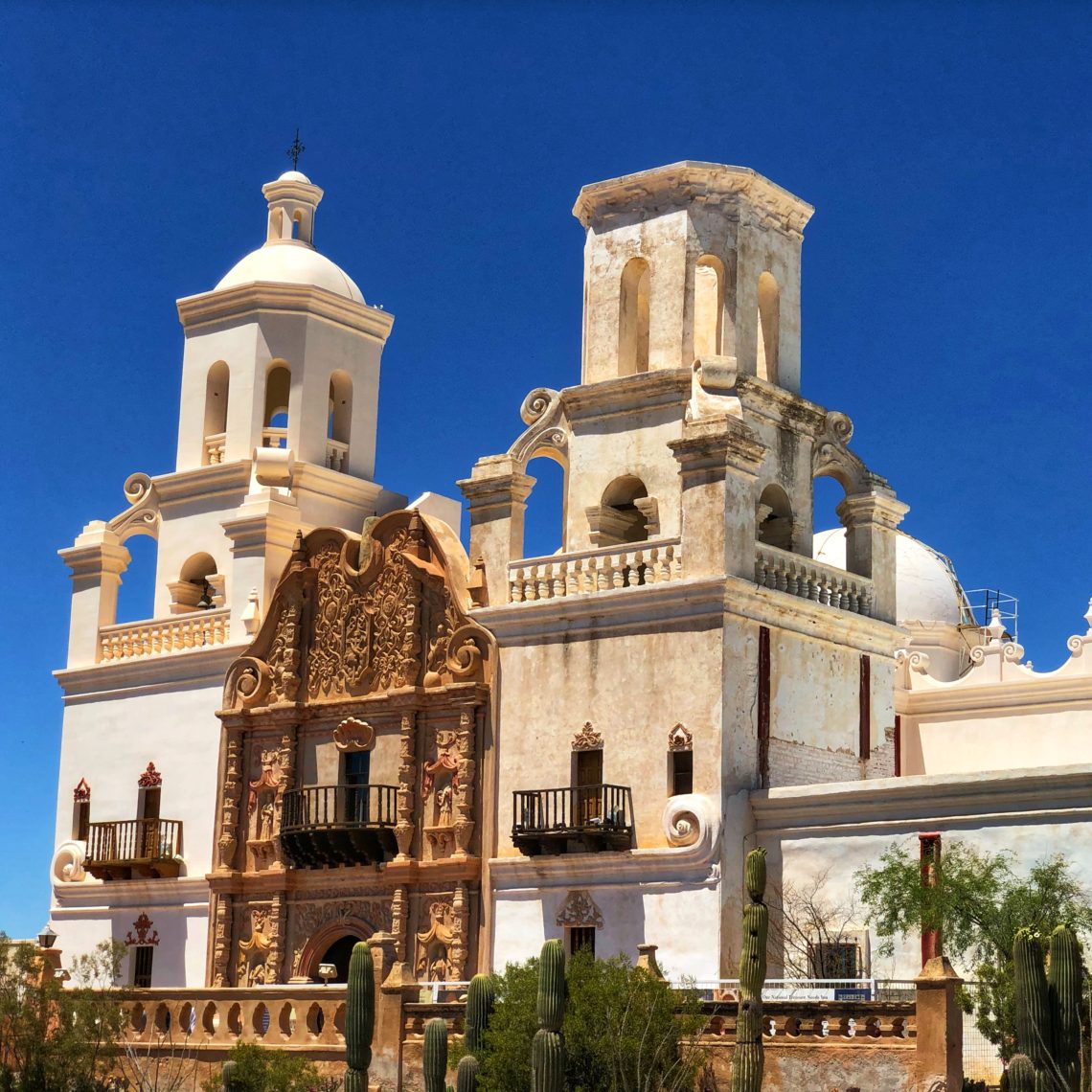
Planning a Trip to See Spanish Missions in Arizona
Exploring the Spanish Missions in Arizona can be accomplished with a day trip from either Tucson or Phoenix. Public transportation is not readily available in this area; you will need a car for this trip.
Southern Arizona, just a little north of present-day Mexico, is the ideal location to explore the history of Spanish Colonial Missions originally established by Jesuit and Franciscan priests. Here, in the Sonoran Desert, you will find two Spanish missions and a Presidio. Both missions were built in the late 1600s and early 1700s. This may not be old for other parts of the world, but for what is now the United States, these are very old buildings.
This post contains affiliate links. If you make a purchase using a link on this page, you will not pay a penny more, but we may receive a small commission. See full details in the disclosure policy here.
San Xavier del Bac
The first stop on your historical tour of Spanish missions in Arizona will be San Xavier del Bac, located just 9 miles south of downtown Tucson.
History of Mission San Xavier del Bac
This is the oldest intact European structure in Arizona. It is a National Historic Landmark, founded as a Catholic mission by Father Eusebio Kino in 1692. Construction of the current mission church building began in 1783 under the direction of Franciscan missionary Father Juan Bautista Velderrain. The architect, Ignacio Gaona, designed the church. Construction of the church stopped in 1797.⠀
The Mission San Xavier del Bac is also known as the white dove of the desert. Viewed from afar it appears to rise up from the desert as a bright white building.

The church is an authentic 18th-century building in the Baroque architecture style with beautiful murals and statues. It is constructed of low-fire clay brick, stone and lime mortar. The entire structure is roofed with masonry vaults, making it unique among Spanish Colonial buildings within the United States.⠀Restoration projects are ongoing when funds permit. Curiously, the initial construction on the church was never completed and no one is quite sure why.

Many interesting details can be seen if you take the time to look closely. When entering the church, be sure to look up and find the cat and the mouse in the sculpture on the facade of the building. Legend has it that when the cat catches the mouse the world will end. Notice the cat and mouse sculpted in each of the bottom corners.
⠀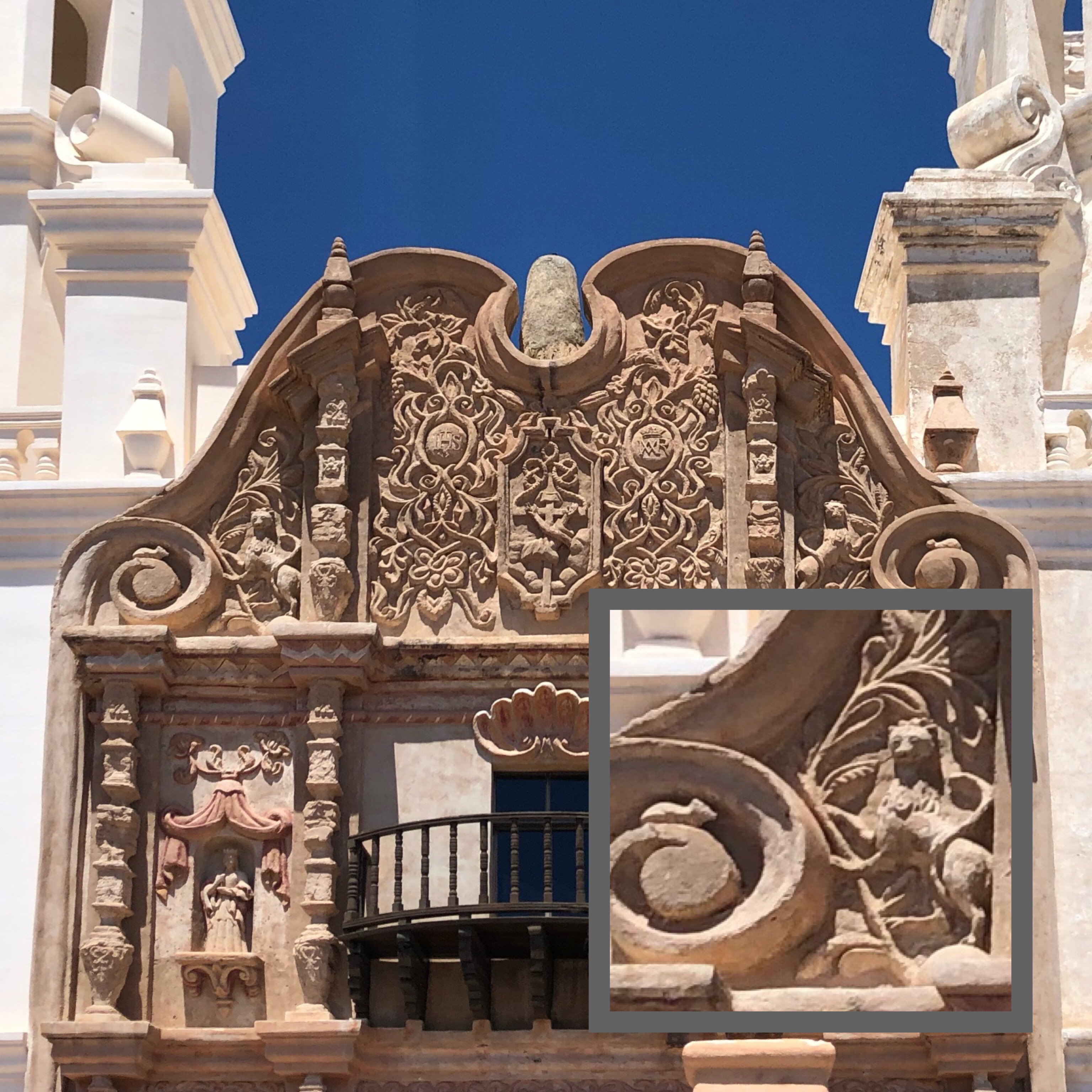
Today San Xavier del Bac is still a functioning Catholic Church. We first visited on a Sunday morning and could not go inside because the mass was in progress and all the pews were full of people. We later returned on a weekday to see the colorful inside.
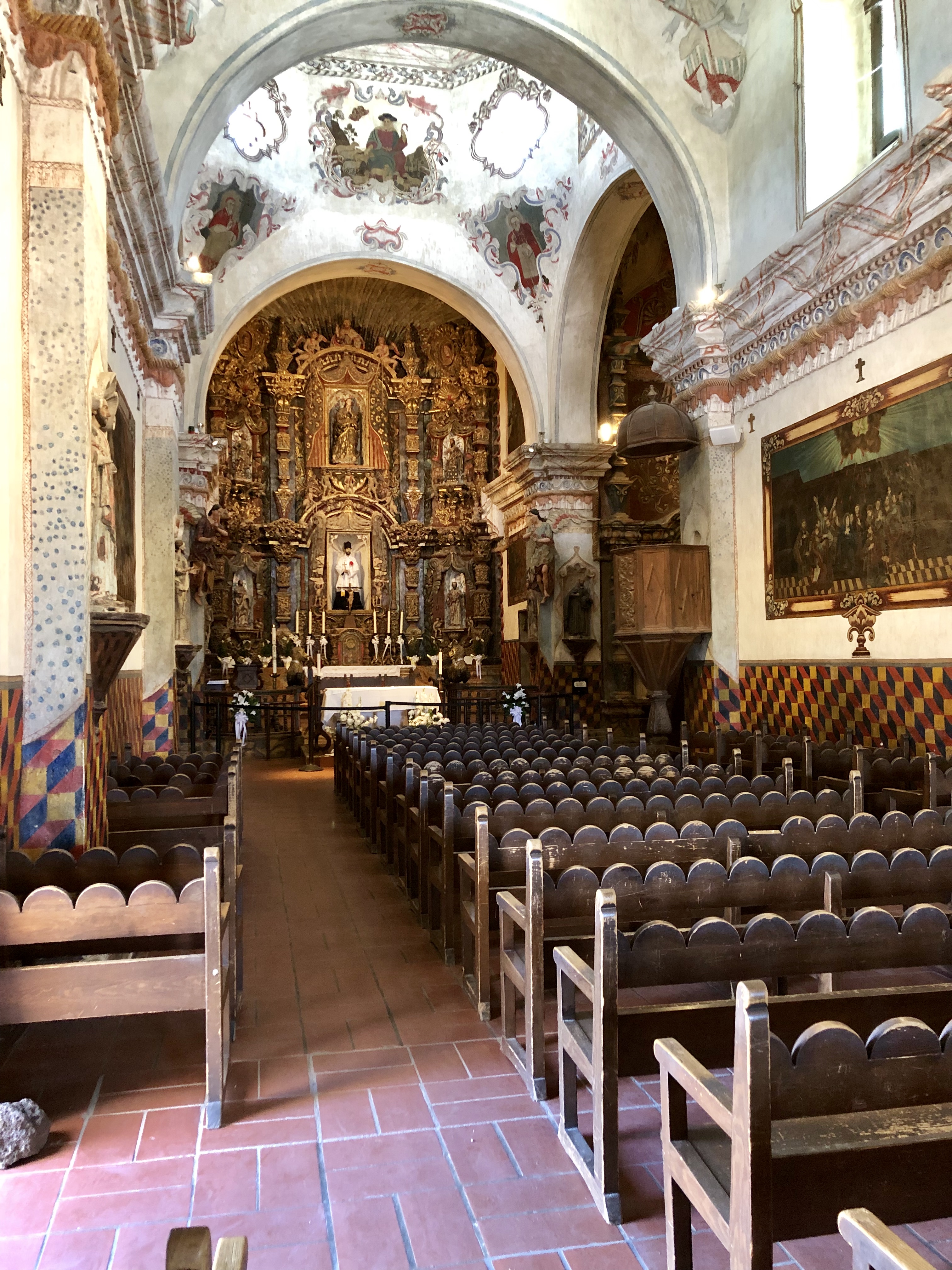
Docents offer guided tours Monday through Saturday mornings, or you can wander around on your own. There is no admission fee, but donations are gladly accepted.
The church is open to the public from 7:00 am to 5:00 pm daily. Friendly and helpful volunteers are a wealth of knowledge and are happy to share interesting tidbits of information.
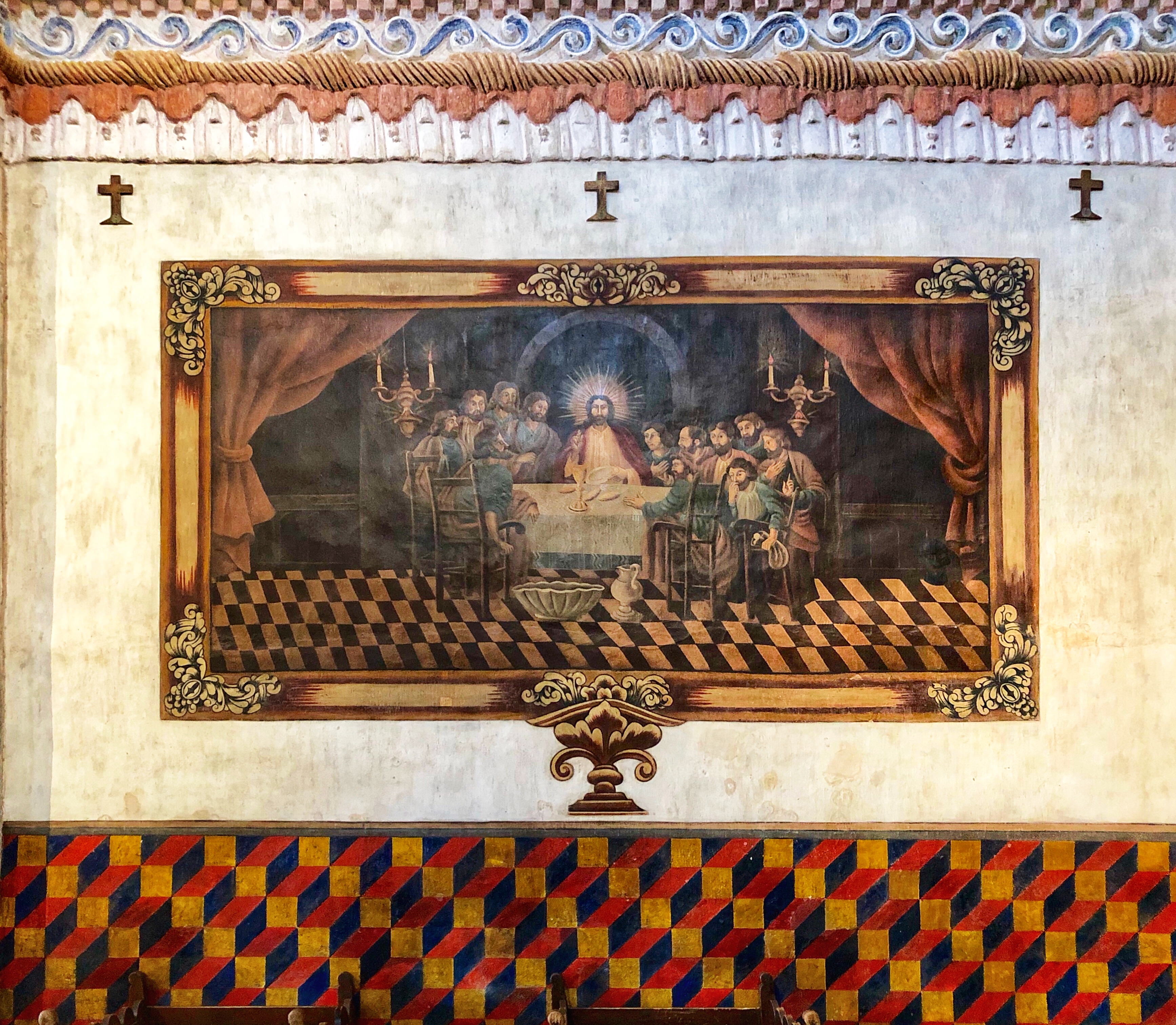
When viewing the Last Supper mural, be sure to see if you can spot Satan. I didn’t notice it at first, but a docent asked me if I saw Satan in the mural so I went back and studied it again. He is there, and once you notice it, he is hard to miss and kind of disturbing.
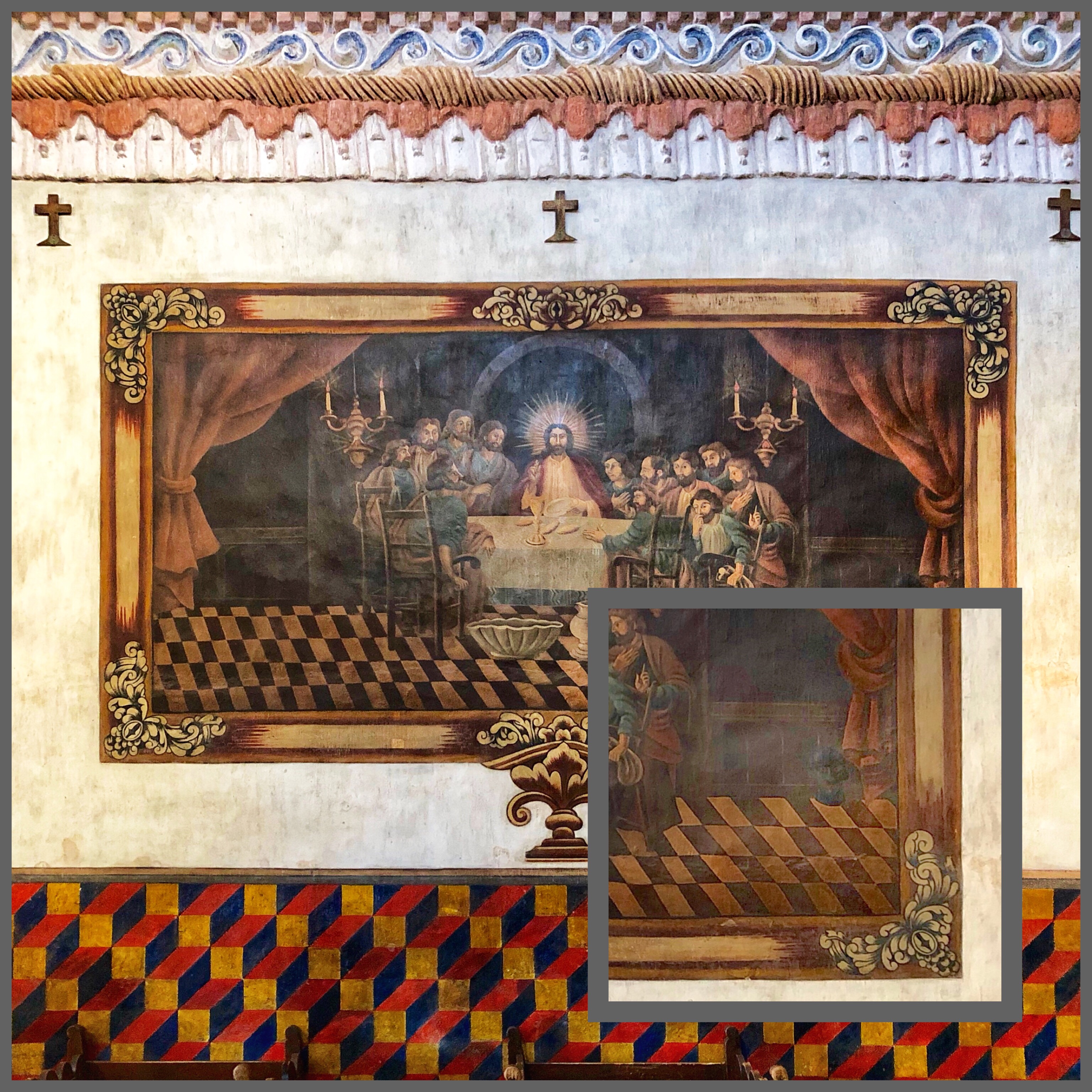
Directions
From Tucson, head south on Interstate 19 to Exit 92, San Xavier Road and follow the signs. The church is located only three minutes from the highway.

Fun fact: I-19 is the only highway in the United States where distance is measured in kilometers instead of miles. The interstate runs the 63 miles between Tucson, Arizona and Nogales, Arizona, at the Mexico border. The interstate was constructed at a time when the United States was making plans to switch to the metric system. This conversion to the metric system never happened, but the signage on the interstate still reflects kilometers.
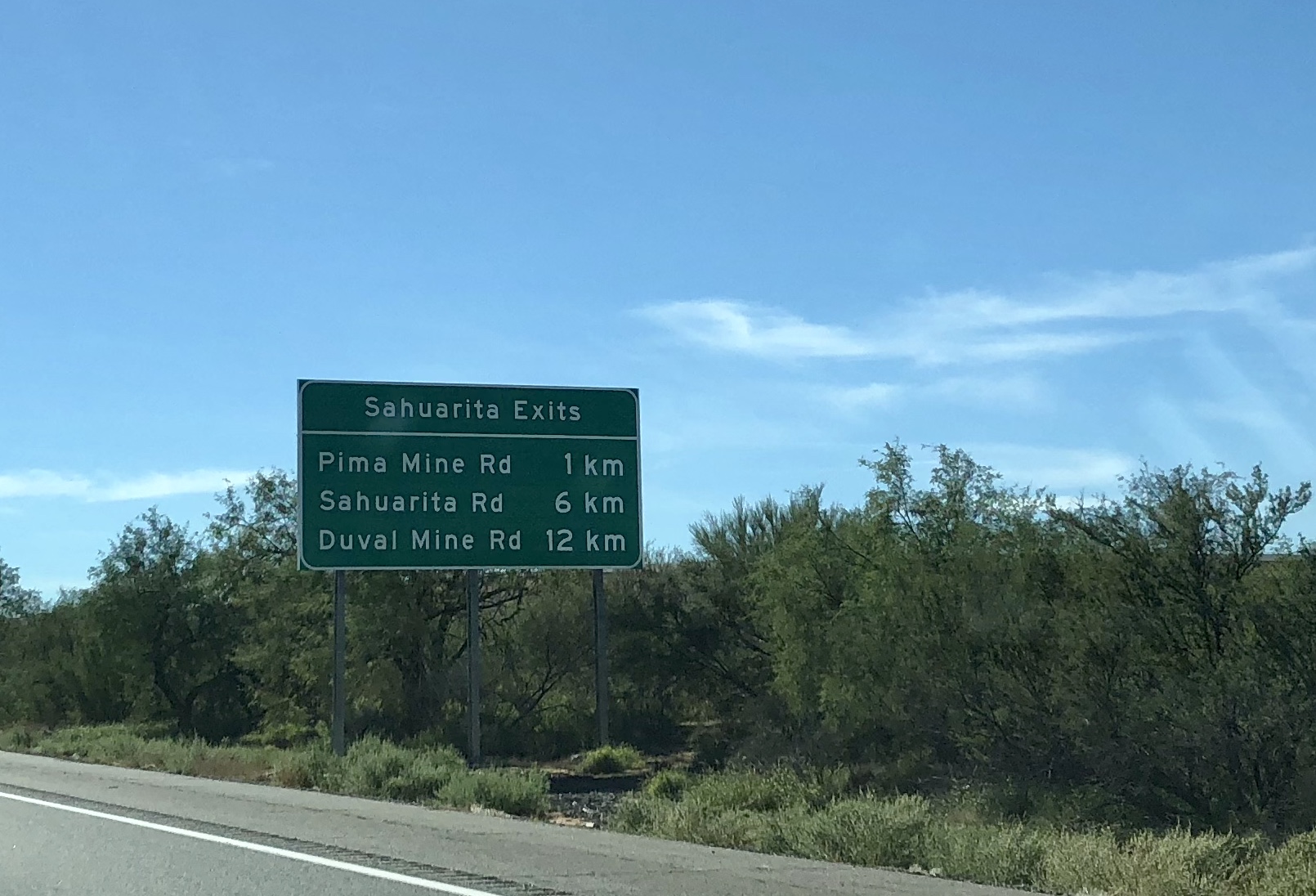
Tumacácori National Historical Park

Directions
After your visit to San Xavier del Bac continue south on Interstate 19 past the town of Tubac, AZ to exit 34. About 40 miles (64 kilometers) from San Xavier you will come to Tumacácori National Historical Monument, another Spanish mission in Arizona.
Admission Fee
Tumacácori, located in the Santa Cruz River Valley, is now a National Historical Park operated by the National Park Service. As of the time of this writing, the admission fee was $7.00 per adult (age 16 or older). Entrance to the park is always free for kids and US National Park pass-holders.

Once inside, there is a well-stocked gift shop for souvenirs and interesting books. Your first stop should be watching the 14-minute movie explaining the history of the mission. You can borrow a brochure for a comprehensive self-guided tour of the grounds and buildings of the mission. If you have kids (or if you are a kid at heart), they can participate in the Junior Ranger program and earn a badge after learning about the park.
The grounds of the park include the remarkably well-preserved church building of the Mission San José de Tumacácori.

History of Tumacácori
Father Eusebio Francisco Kino, a Spanish Jesuit Missionary, traveled into what is now Southern Arizona and encountered the O’odham Indians living along the lush riverbanks of the Santa Cruz River. The Catholic missionaries called these people the Pima Indians and named the area Pimería Alta which, in Spanish, means place of the Upper Pima. Father Kino established Cayetano de Tumacácori on the Santa Cruz River’s east bank as a Catholic mission in January 1691, making it the oldest mission site in what is now Southern Arizona. Father Kino worked to bring his religion to the O’odham people (who he called Pima Indians).
In 1767, the King expelled all Jesuit missionaries from Spanish lands. The Franciscans took over the missionary work in the area and in 1800 Fray Narciso Gutiérrez began to build a large church to replace Tumacácori’s modest Jesuit structure. Work started with the hopes of a church as grand as the building at San Xavier del Bac. The church building sits on five-foot thick cobblestone foundations, but the work was stop-and-go over the next several years, as funding was not always available.
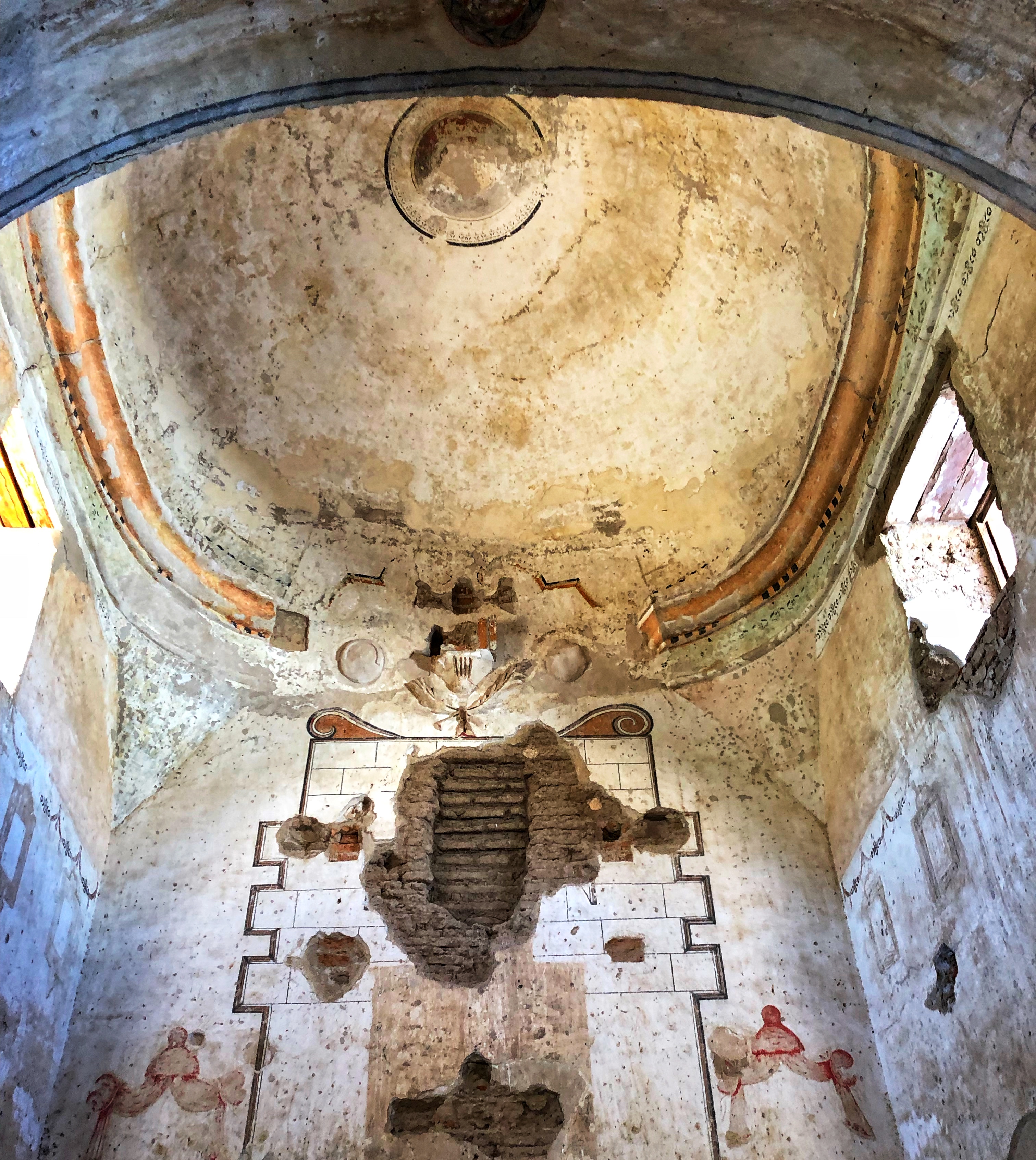
Eventually, in 1828 a Mexican decree forced all Spanish-born residents to leave the country, and Tumacácori lost its last priest. For the next 20 years, Mexican priests tended to the mission, but Tumacácori was abandoned and in disrepair by 1848. Construction of the bell tower and dome were never finished. With the Gadsden Purchase of 1854, the mission and all of the surrounding Arizona Territory became part of the United States. ⠀

There is a mortuary chapel near the cemetery at Tumacácori mission.
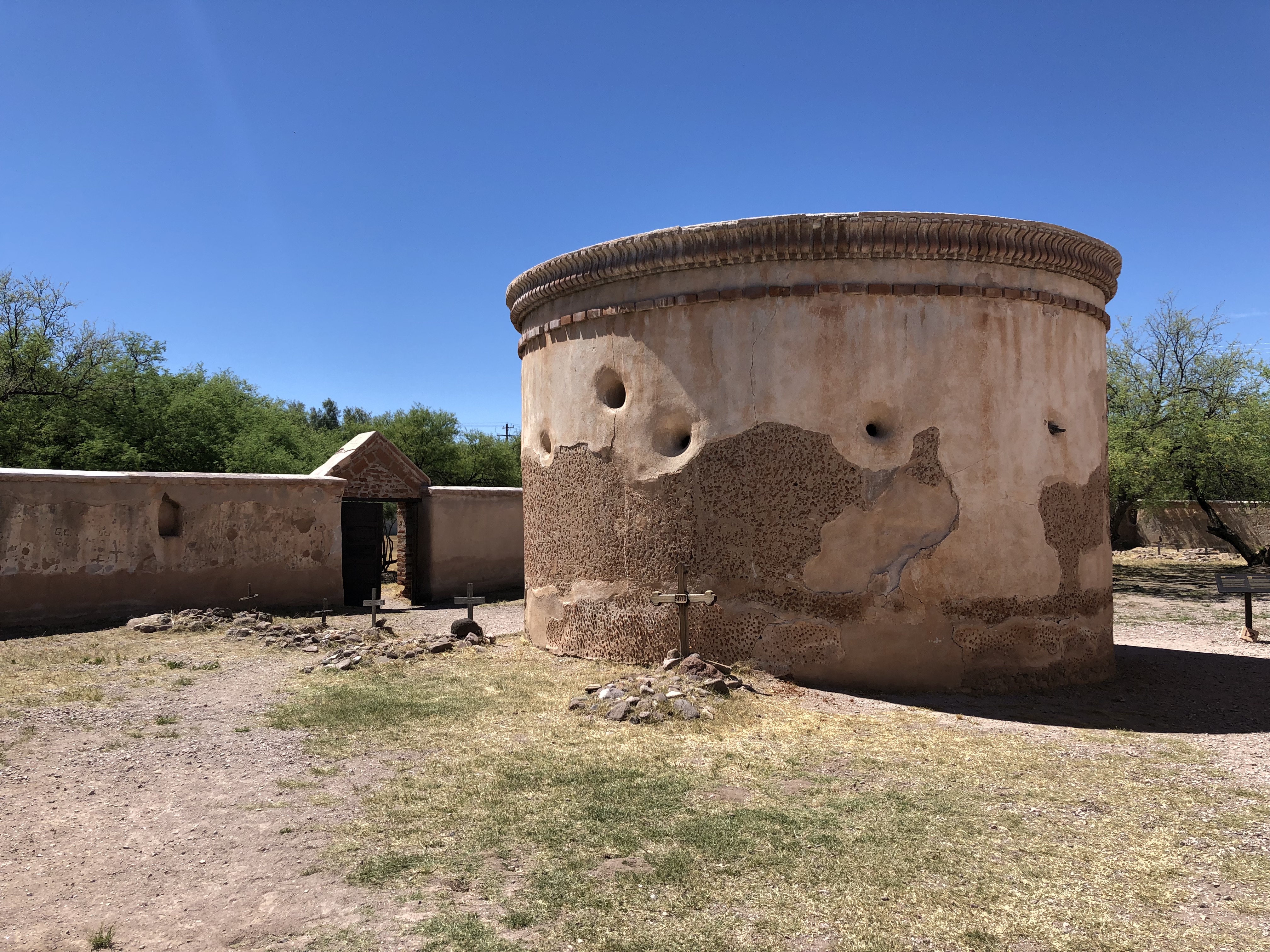
Over 590 burials were recorded here at Tumacácori between 1755 and 1825.

⠀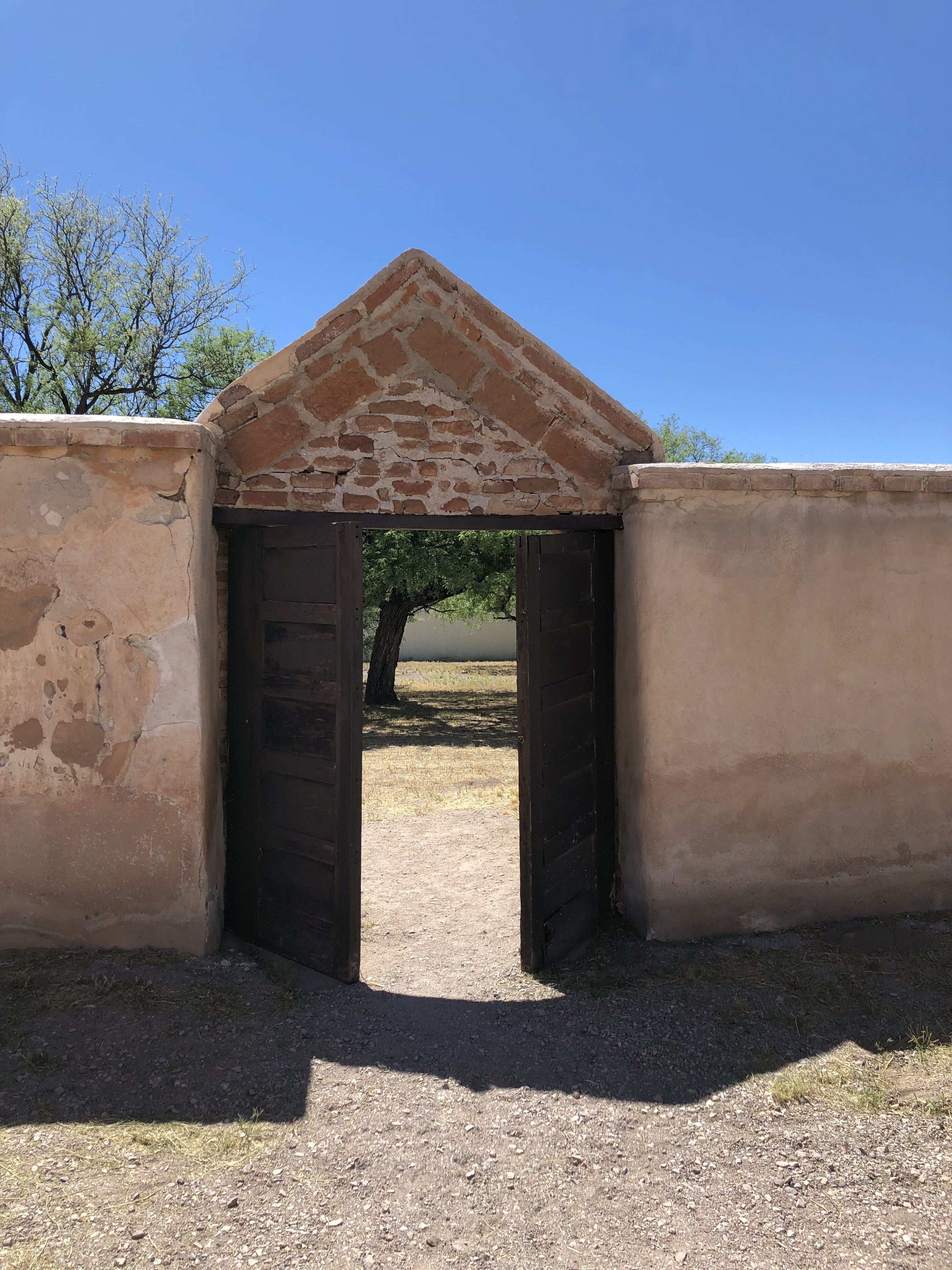
After visiting the mission, head north again on Interstate 19 and stop in the town of Tubac. If you have time, I recommend staying overnight at the Tubac Golf Resort and Spa for a very relaxing visit and spa treatment. It is one of our favorite resorts for a getaway weekend. You can read all about why you should stay at the Tubac Golf Resort and see a room tour and video of the resort.
If you want to complete your trip and return to the city in one day, grab a bite to eat and continue on.

Tubac Presidio State Historic Park
If more colonial history is what you are looking for, make your next stop the Tubac Presidio State Historic Park. This is an Arizona State Historic Park located in Tubac, Arizona.
Admission Fee
The entrance fee is $7 per adult, $2 for kids 7-13 and six and under are admitted free.

History of the Tubac Presidio
As the Spanish Empire was expanding into what is now the southwestern United States, Catholic missions were being established (as we learned at our visits to Tumacácori and San Xavier del Bac). Tubac was set up as a mission farm and ranch. In 1751 the Pimas, led by Luis of Saric, fought against Spanish rule and destroyed the settlement at Tubac. In 1752 the Pimas surrendered, and the Presidio San Ignacio de Tubac was established by royal decree of the King of Spain to protect the town and settlers from further rebellion and attack by the Apaches. Thus, Tubac became the first European settlement in what today is the state of Arizona.
Many different government units have controlled Tubac over the years. New Spain, Mexico, the United States of America (when the Gadsden Purchase acquired the southern part of what is now Arizona on December 30, 1853), New Mexico Territory, The Confederate States of America, and the Arizona Territory which eventually became the State of Arizona.
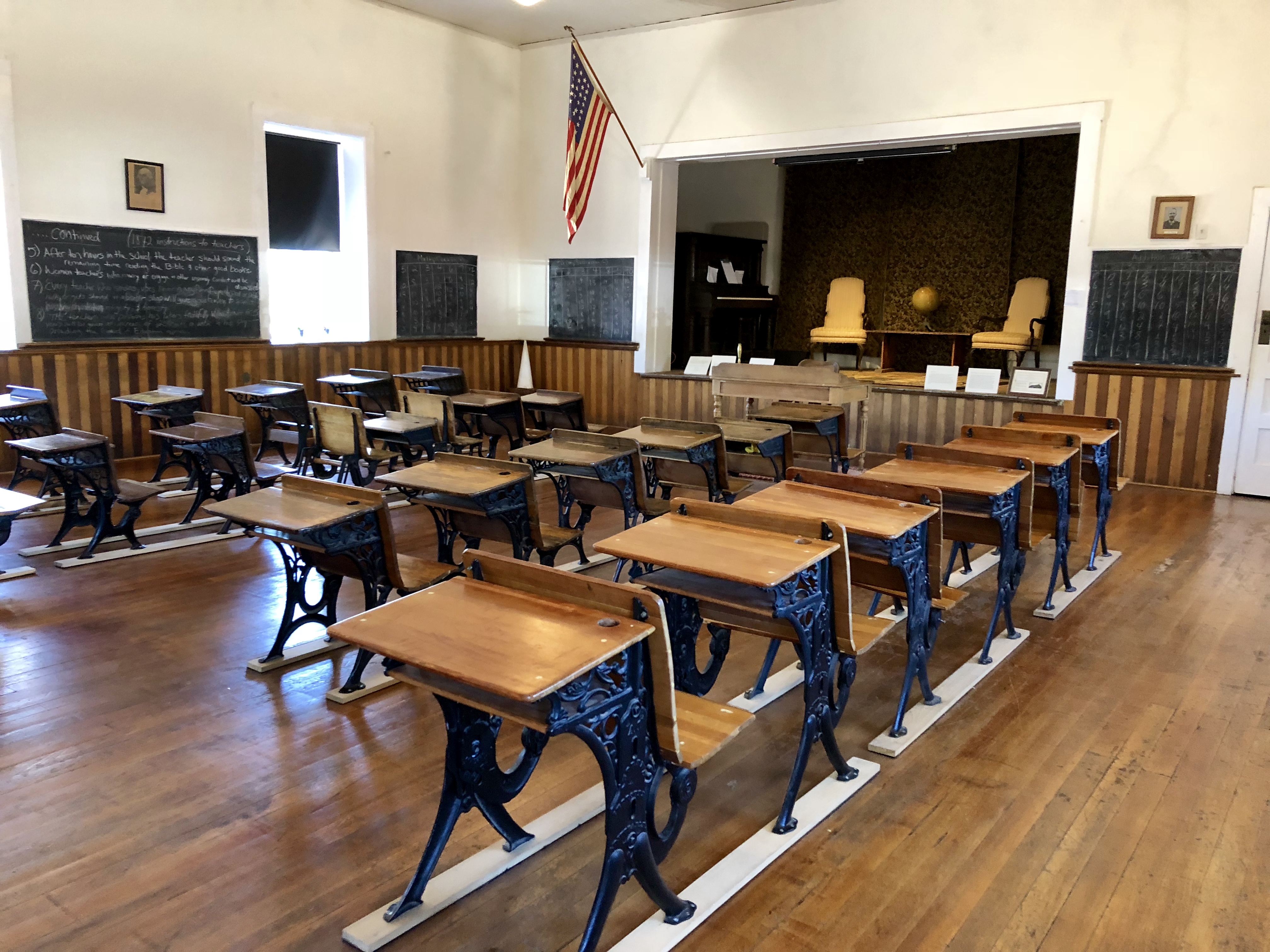
At the Tubac Presidio State Park, there is a visitor center with a video presentation and a scale model of the entire Presidio. The museum has original artifacts and interpretive exhibits. The park is also the site of an 1885 Territorial Schoolhouse which is the second oldest schoolhouse in Arizona. This one-room schoolhouse has antique desks and a pot belly stove.

Around the grounds outside, various exhibits show how people lived, cooked, and worked in Spanish Colonial times. Travel down the “Stairway to the Past” to enter the air-conditioned structure showcasing the archeological dig conducted in the 1970s by the University of Arizona. Here you can see the archeological excavation of some of the original Presidio walls along with unique artifacts that were discovered during various levels of the excavation project.
As you finish your exploration of the Spanish missions in Arizona and head back north towards Tucson, if modern history is more to your liking, be sure to check out the underground tour of the Titan Missile silo for a unique and detailed look at a cold-war era military installation. Read details about the Titan Missile Museum Tour and suggestions for restaurants in the area here.
Route for the Spanish Missions in Arizona trip
Here is a map of the route you will cover to see the missions and presidio. We found Google maps to be accurate in guiding us to the locations. There are signs on the highway for each attraction making this a simple-to-navigate trip.
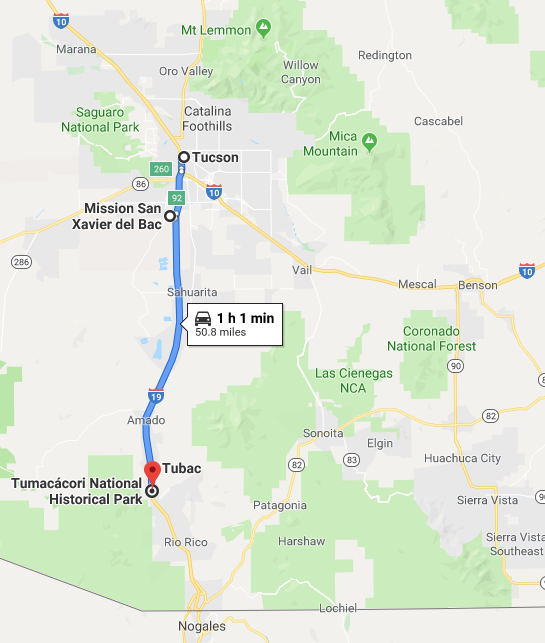
Planning your visit to the Spanish Missions in Arizona
Be prepared for warm temperatures and hot sunshine for this adventure. Average temperatures in Southern Arizona are well over 90 degrees during the months of June through September. May and October will also be quite warm. Visiting in the winter months would be ideal, but sunburn is possible even in January. Being prepared for the bright sun and warm temperatures is advisable year-round here in Arizona. A hat that blocks the sun is always a good idea. I especially like one that is packable and can be rolled for packing like this one. If you notice, in the photo of me at Tumacácori (below) I am wearing UV protection sleeves. I have started taking these lightweight sleeves with me on our adventures. When we arrive at a location where I will be outside in the sun, I can easily roll the sleeves onto my arms. Later, when we are back in the car or will be inside for a long time, they are easy to roll off and put into my pocket. These are effective for sun protection without the chemicals and bother of a lotion sunscreen! These particular sleeves are cooling as well as providing protection from the sun. I have also used the sleeves on long hikes and am very happy with how well they cool and protect from sunburn. Lastly, be sure to travel with a reusable water bottle to stay hydrated. I love the Grayl Filtering Reusable Water Bottle. I can simply refill it with water from any source. It quickly and easily filters the water and I will have delicious-tasting, safe-to-drink water.

Do you like to visit historical sites when you travel, or do you prefer to explore newer attractions? Let me know in the comments below!
Pack for your trip:
On Pinterest? Use this image to Pin this post:




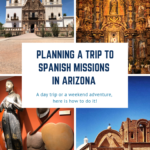
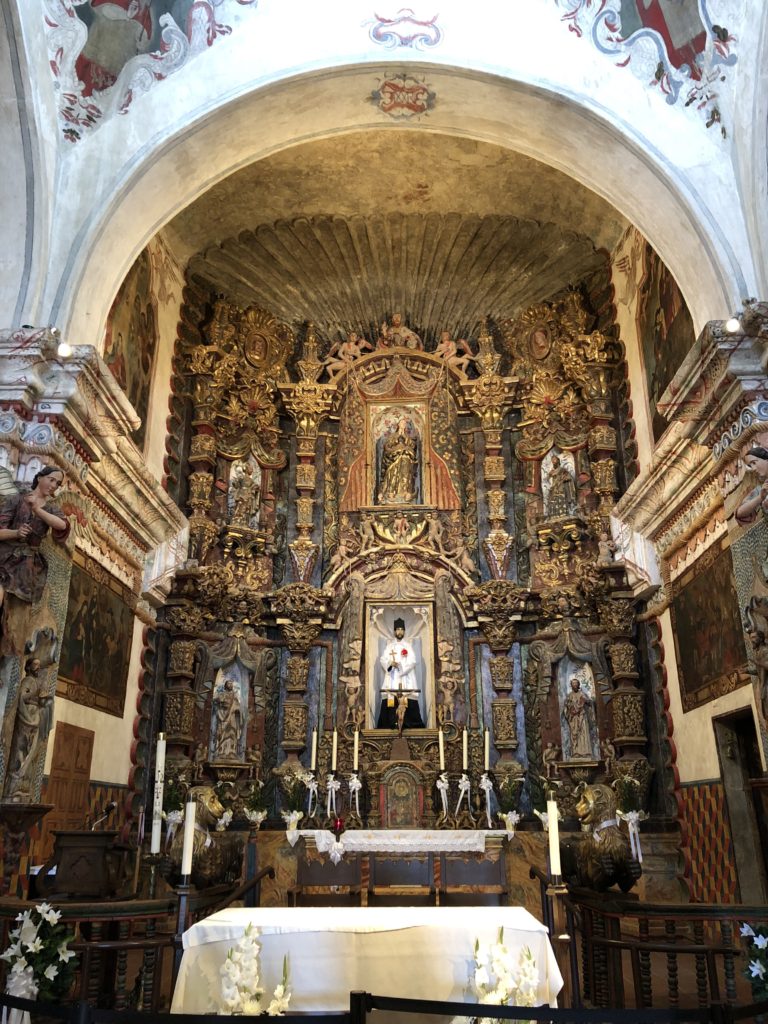


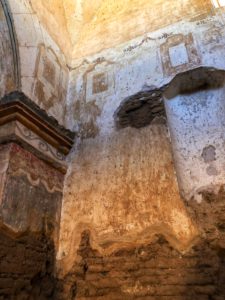
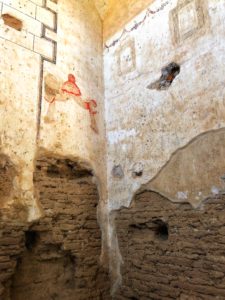
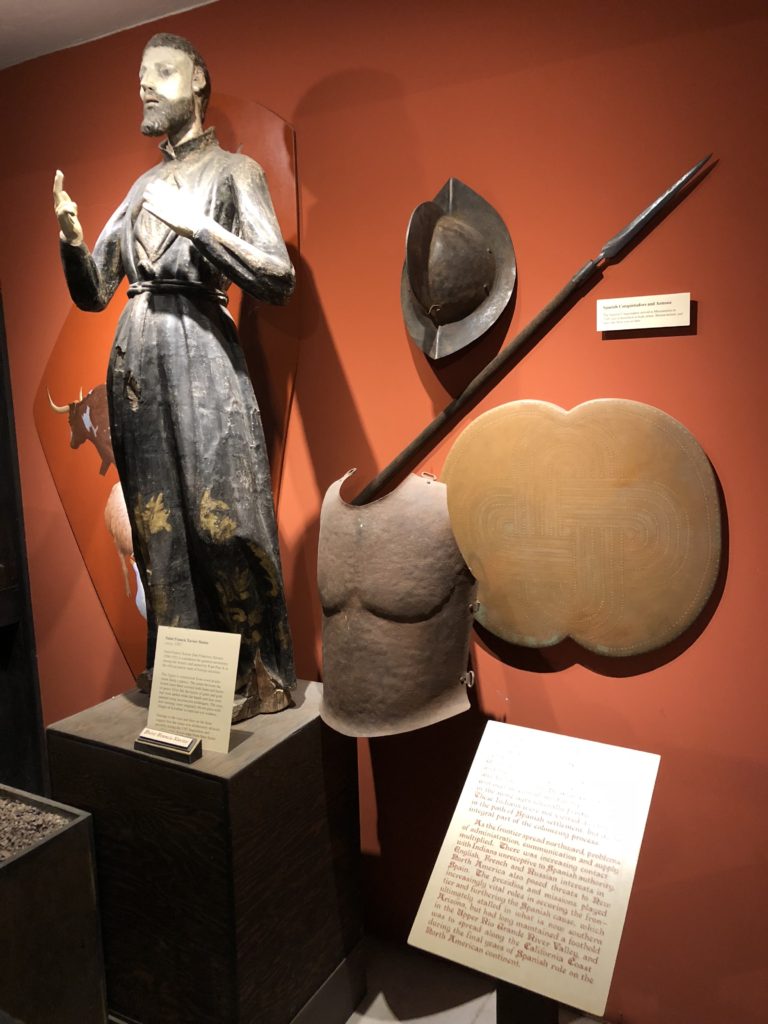

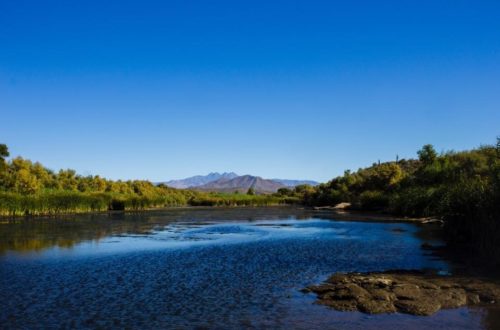


26 Comments
Samara
What a cool post! I’ve never heard of this place but the photos look absolutely stunning! I appreciate all the detail you put in here!
Sheila
Thank you, Samara. I was excited to visit the locations. The church buildings were really well-preserved and interesting.
Elizabeth @ Anchored Adventure Blog
Loved the photos! A good friend recently visited, and I loved following her adventure. Definitely adding to the bucket list (maybe in the fall when it’s not so hot!).
Sheila
Yes, Elizabeth, Waiting until Fall is a good decision, especially if you are not used to the desert heat. The sun will still be hot but the temperatures will be a little better.
MY RIG Adventures
Wow, the detail in these old structures is just phenomenal. How sad that the bell tower was never finished. Your information was very informative, thank you.
Sheila
Thanks for stopping by and commenting. There are some interesting theories why the tower was never finished but no one is certain. One theory is that if it was “unfinished” and still under construction then there would be less tax due – I am not sure if this is true so I didn’t include that in the post.
Sean Brett
I have been thinking about planning a trip to Arizona and the Spanish missions look like a perfect place to visit. Thank you all the details including the price and location. 🙂
Sheila
Thanks for reading, Sean. Arizona is a great destination with so many activities to choose from. Hope you get a chance to visit soon!
April Key Rode
I love how you put it in detail it’s like were there touring with you. I love history but it’s not a great idea to travel and visit historic places with small kids. If they made it more fun for smaller kids it would be great but if it’s similar to Thailand I think I’ll skip until the kids will be older enough to stay put and listen. Thanks for sharing
Sheila
I think that is a good call, April. My parents brought me to San Xavier del Bac when I was a kid and I recall being pretty hot and bored. So much so that it took me over 40 years to want to return! Now that I’m an adult and appreciate history more I thoroughly enjoyed our visits and actually visited twice in one week. The Tumacácori mission could be interesting for older kids (school age) who like to earn the junior ranger badges. San Xavier did not have anything interactive for kids that I noticed.
Danik
I would love to check out these places, not just because they old structures with beautiful decor/facades but because of their history as well. So much detail written here I felt like I was there with you. Havent been to Arizona yet, so hope to tick this one off soon andif I am in the area, would love to check these out.
Sheila
I hope you get to visit soon, Danik. Thank you for reading. The missions have so much to see. If you are interested in the history of the places, you could spend a long time in each location.
anshul
I enjoy exploring and analyzing architecture during my travels. I guess, these Spanish missions would give me enough reasons to experience that part of traveling. I have heard a lot about Arizona’s unique topography so it will be a best of both worlds.
Sheila
Arizona does have many beautiful locations. From the obvious must-see sites like the Grand Canyon to the lesser known locations like these missions, all are worth visiting.
The Holidaymaker
Such a fantastic article, I love the detail to which it is written and you take beautiful photos. I couldn’t find Satan until I saw your enlargement, but likely if you are seeing it in person it would then be hard to miss it. Love the fun fact, I knew that US wanted to convert to km but never ended up doing so, and love the sign that still tells that story. Glad to have read this post!
Sheila
Thanks for stopping by! I completely missed the head of Satan until the docent asked me about it. Even then I had to study the mural for a while before I could find it! Kind of weird that it is not noticeable unless looking. Thank you for the photo compliment. The building was so pretty it was easy to take great pictures, the hard part was timing it so there were no other people in the shots. An exercise in patience for sure!
Kellie
It was such a pleasure reading your article, and your photography is incredible! I still have not made it to Arizona, so I will add this to my list 🙂 !
Sheila
Thank you for the compliment, Kellie. I appreciate your kind words. Arizona is great, so much to do and such beautiful terrain. I hope you make it out soon.
Cynthia / Adventuring Woman
I LOVE to visit historical sites! Love to learn the history behind them, too. The “stairway to the past” and exhibits showing how people lived at Tumacacori would be fascinating. Thanks for giving some background info on each site. San Xavier del Bac is truly a stunning building. Pinning the post for future reference, would love to visit Arizona!
Sheila
Thanks for stopping by, Cynthia. Most of the buildings you find in Arizona are not as old as the historical sites in Europe but I was happy to find that what we do have here was so well preserved. If you plan to visit Arizona, I recommend the winter or spring. Beautiful weather and not scorching temperatures like we have in the summer.
Bernie and Jess Watt
Wow, these are real treasures – a little bit of baroque Europe in the desert. Lovely photos too.
Sheila
Thanks! It was a unique find and fun to visit.
aav amphibs
It is very common to see old churches still in use south of the border from Mexico to Argentina. Very old churches, built in the 1500s. I’ve seen beautiful churches in Panama, Mexico City, Philippines, in the Yucatan, and not very uncommon at all. Interestingly, in the United States. I’ve seen beautiful missions in San Antonio and Goliad, some of which are still in use. That first mission you showed, San Xavier de Balc displays a facade much like one I’ve seen in Panama City, Panama. I’ve also seen some Franciscan ruins in Antigua Guatemala, a mega complex of former beautiful churches and surrounding buildings. Most of those had been knocked over by earthquakes. One bar was built right there overlooking old ruins brought down by earthquakes. Very interesting stuff. One thing I like about the U.S. Spanish Missions is how well they get kept up. The missions have been reconstructed to the best specs possible. A lot of these missions were built with adobe or wood, or later limestone in Texas to beef up fortifications from Indian raids. The Alamo in San Antonio was nothing more than surrounding wall. Doesn’t look like anything like it looked back then. Keep that in mind. And of course. If you haven’t been to Spain, and its elaborate old churches dating back way before ours in the U.S. you aint seen nothin yet.
Sheila
Thank you for the detailed, interesting comments! I hope to get to Spain soon. The churches and other buildings there must be incredible to see.
aav amphibs
One other interesting place worth mentioning. Down town Lima Peru, Catedral de San Francisco. They have bodies buried underneath the church dating back from the 1500s You can still see the skeletons through a sight glass. You can take a tour there for peanuts. Like 2 bucks with a tour. The guide will give you quite some history of the Spanish conquest and the church. They have interesting paintings with indigenous twist. Like the last supper, Jesus and disciples having a meal and on the table there is CUY. What is CUY? Its guinea pig. A delicacy in Peru.
Sheila
I recently learned about Cuy. Not sure if I’m adventurous enough to try it, my niece has a guinea pig as a pet. Might be a bit of a stretch for me to actually eat it! The tour of the cathedral in Peru sounds incredible. Thanks for sharing the info.